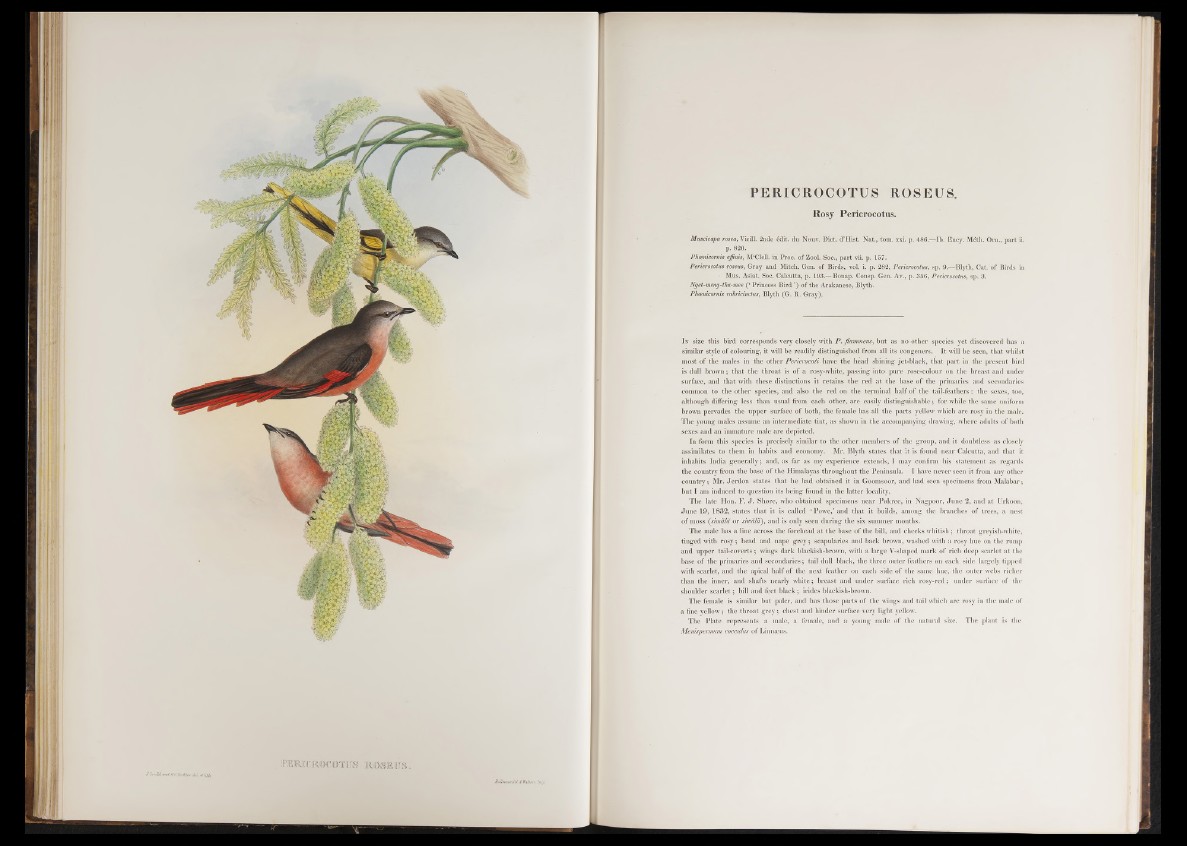
PERICK.OCQTUS 1
PERICROCOTUS ROSEUS.
Rosy Pericrocotus.
Muscicapa rosea, Vieill. 2nde edit, du Nouv. Diet. d’Hist. Nat., tom. xxi. p. 486.—lb. Ency. Meth. Orn., part ii.
p. 820.
Phamicomis ajfmis, M'Clell. in Proc. of Zool. Soc., part vii. p. 157.
Pericrocotus roseus, Gray and Mitch. Gen. of Birds, vol. i. p. 282, Pericrocotus, sp. 9.—Blyth, Cat. of Birds in
• Mus. Asiat. Soc. Calcutta, p. 193.— Bonap. Consp. Gen. Av., p. 356, Pericrocotus, sp. 3.
Nget-meng-tha-mee Princess Bird ’) of the Arakanese, Blyth.
Phcenicomis rubricinctus, Blyth (G. R. Gray).
In size this bird corresponds very closely with P . flammeus, but as no other species yet discovered has a
similar style of colouring, it will he readily distinguished from all its congeners. I t will be seen, that whilst
most of the males in the other Pericrocoti have the head shining jet-black, that p art in the present bird
is dull brown; that the throat is o f a rosy-white, passing into pure rose-colour on the breast and under
surface, and that with these distinctions it retains the red at the base of the primaries and secondaries
common to the other species, and also the red on the terminal half o f the tail-feathers: the sexes, too,
although differing less than usual from each other, are easily distinguishable; for while the same uniform
brown pervades the upper surface of both, the female has all the parts yellow which are rosy in the male.
The young males assume an intermediate tint, as shown in the accompanying drawing, where adults o f both
sexes and an immature male are depicted.
In form this species is precisely similar to the other members o f the group, and it doubtless as closely
assimilates to them in habits and economy. Mr. Blyth states that it is found near Calcutta, and that it
inhabits India generally; and, as far as my experience extends, I may confirm his statement as regards
the country from the base of the Himalayas throughout the Peninsula. I have never seen it from any other
country; Mr. Jerdon states that he had obtained it in Goomsoor, and had seen specimens from Malabar;
but I am induced to question its being found in the latter locality.
The late Hon. F. J . Shore, who obtained specimens near Pokree, in Nagpoor, Ju n e 2, and a t Urkoon,
June 19, 1832, states that it is called ‘ Powe,’ and that it builds, among the branches of trees, a nest
of moss (simala or siwala), and is only seen during the six summer months.
The male has a line across the forehead at the base of the bill, and cheeks w hitish; throat greyish-white,
tinged with rosy; head and nape g re y ; scapularies and back brown, washed with a rosy hue on the rump
and upper tail-coverts; wings dark blackish-brown, with a large V-shaped mark of rich deep scarlet at the
base of the primaries and secondaries; tail dull black, the three outer feathers on each side largely tipped
with scarlet, and the apical half o f the next feather on each side of the same hue, the outer webs richer
than the inner, and shafts nearly white; breast and under surface rich rosy-red; under surface of the
shoulder sc a rle t; bill and feet black; irides blackish-brown.
The female is similar but paler, and has those parts o f the wings and tail which are rosy in the male of
a fine yellow; the throat g rey ; chest and hinder surface very light yellow.
The Plate represents a male, a female, and a young male of the natural size. The plant is the
Metiispermum cocculus of Linnasus.